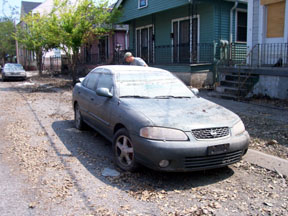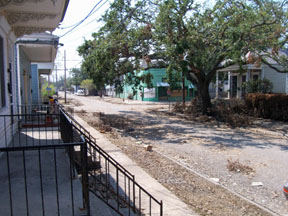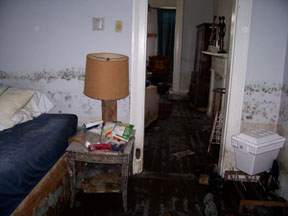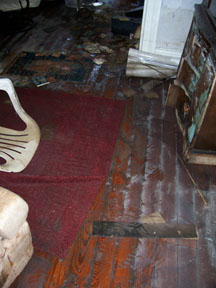|
Web Exclusives: PawPlus
October 19, 2005: Back
to New Orleans On Sept. 20, my mom and I went home to New Orleans for the first time since Katrina hit. Here is the story: We had no trouble getting into the city, even though the local radio, which has been consolidated into one station, announced that the National Guard was turning people back. I have to say it was pretty much what we expected, but what we expected was pretty bad. Uptown, near my mom’s house, debris – mostly dead brown tree branches – lined every single street. Power lines hung in the middle of the street. You quickly became used to seeing downed trees and major, but mostly reparable, damage to houses. No traffic lights were operating. There were almost no cars on the streets. Most vehicles were military, construction (from all over the country) or “semi-official,” i.e., regular or rental vehicles with company stickers on the sides. One vehicle, with a family inside, even had a poster board taped to the windshield with “Animal Rescue” written on it – probably a ruse to get past the National Guard. We saw the Rite Aid at Carrollton and Oak, with the forklift used to break in still stuck in the door. There was a line of Humvees and troop transport vehicles in Audubon Park. One thing was clear at this point: At least in Uptown New Orleans, there needs to be very little “rebuilding” beyond the cleanup, minor repairs, and a few cosmetic changes. The streetcar tracks will take a while to clear, downed telephone poles and power lines will have to be repaired, and that will take a while. The volume of debris to be moved out of the city will be enormous. Mom’s house was absolutely fine, save for a few tiles blown off the roof and some pipe damage. There was no mildew or mold, except on a box of blueberries left out. The water ran and the toilets flushed, but there was no power. We drove downtown along St. Charles Avenue, and it was more of the same. There were several signs discouraging looting, some of them amusing. A cop stopped in front of us to take a picture. Overall, it seems that there was relatively little structural damage. All over the central business district, there are work crews pumping water and making repairs. Poydras Street is now lined with stop signs. Driving into my neighborhood, you could see a brown water line on every single structure. All plant life below the line was dead and brown – grass, bushes, fallen leaves, gardens, etc. The metal water meters in the grass in front of my house had rusted. People talk about the smell. Stepping out of the car in front of my house is where I first noticed it. It was more distinct than it was overwhelming. It wasn’t horrible, just generally unpleasant, maybe something like rotting citrus fruit. My car, still in front of my house, had turned white with decay and debris. Before the storm, it had needed several minor repairs, and now I was thankful that in my laziness I never got around to them. The trunk was open, and all of its contents had been taken or floated away. All I really missed was the tennis racquet in the trunk. One of the tires had collapsed. The wheels were rusted. Mud and tree branches hung from the side mirrors. The doors still opened, which let me get the papers (those that were salvageable). There was a small puddle of water in the back seat. From reports and photographs, I knew that there had been about two feet of water in the house. So over the last few weeks I had been wondering what objects in my house had been more than two feet off the floor, and hoping I could save them. I had trouble opening my door, at first because I thought it had swollen shut from the water. After pounding it a few times, I realized that something inside the house had pushed up against it – as it turned out, a blue paper recycling bin and my couch. This is what my house looked like inside, with two feet of water: brown stains up to two feet on the walls. A foot above that, a line of green, brown, and black splotches of mold. Everything but the heavy furniture (and even some of that) was out of place. The refrigerator had floated and was knocked over, as was the microwave that was on top of it. Drawers were swollen shut and their bottoms collapsed. A thin film of slippery gray silt coated the floor and everything that had been on the floor. One small dresser had floated from one room to another and been deposited on its side. Imagine that scene, thousands of times over. Before evacuating, my “preparation” consisted of putting most of my photographs on top of my dresser, “just in case.” They survived just fine. There was no sign of life at all on my street. No movement from any house. No cats, or squirrels, or birds. My neighbor had said he would ride out the storm, and he had kindly boarded up one window of my house and sealed the screen door. I have no idea where he is right now. I am much more sentimental about the loss of my city than the loss of my stuff. Looking back, it seems so easy to be gung ho about rebuilding the city. Standing in the middle of my street, brown debris baking in the sun in every direction, I didn’t see destruction, but the death of the neighborhood. It is hard for me to imagine it ever alive again. It is hard for me to imagine anyone going back. There was nothing at all to return to but empty structures that now house only memories. It’s a vicious circle: If a critical mass does not return to a neighborhood, no one will, and that will be the case in many parts of the city. On the Entergy Web site, there is no timetable for restoring power to my zip code (and several others) despite the fact that it’s easily accessible. No one will say it yet, but the reason is clear: It may be bulldozed. In the news you see interviews with hardy New Orleanians still living in their homes, patiently awaiting the power, cooking out on the porch every night and still managing to find some open bar. It’s a quaint thought, and it’s comforting to think of New Orleans that way. But outside of the central business district and some parts of Uptown, all I saw was emptiness. It’s not charming – quite the contrary. Maybe I will become more optimistic as the city repopulates. I know the smell will go away eventually, and some grass is already regrowing in patches, so I’m optimistic about that. I will go back to New Orleans, but I don’t think I could ever live in my neighborhood again. Unless I have greatly overestimated my own resilience, if I won’t go back to my home that was underwater, few people will. Finally, I should be clear that I’m one of the lucky ones.
I am fine, healthy, and have an amazing support network of friends
throughout the country and the world. Almost everything
I lost was replaceable. Unlike the history of the city, and the
lives of many of its citizens, the history of my life will not
be written in terms of Before Katrina and After Katrina. Tom Andre ’98 produces a New Orleans-themed festival in Brazil called “Jambalaya!” He is also the director of a newly formed organization called the Institute of Culture in the Americas, which aims to help New Orleans cultural organizations form strategic partnerships with others throughout the Americas. The institute is amending its mission to also address questions of race, culture, and poverty and how they are related, Andre says, “with a particular eye on places like Brazil, which like New Orleans boasts an incredibly rich culture constructed mostly by poor people.”
|
||




